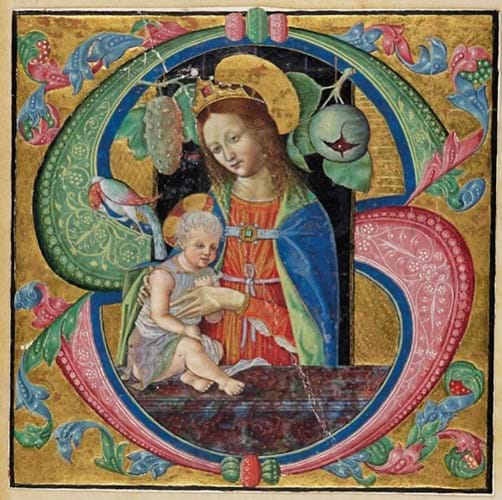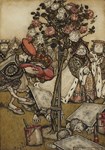Books and works on paper
At Sotheby’s on December 6 the one real star entry, the ‘Bute Hours’, a medieval manuscript billed as “one of the most valuable English manuscripts ever to appear at auction” and valued at £1.5-2.5m, failed to sell.
A similar fate had defined the opening, manuscript section of a December 1 sale at Christie’s, where the five higher-valued, six-figure lots were all left unsold.
Among the King Street failures the most notable casualty was the ‘Clumber Bible’, a gargantuan and lavishly illustrated manuscript produced in Paris or Rouen, c.1395, that had been estimated at £800,000-1.2m.
One notable success in the King
Street sale, however, was provided by the beautiful illuminated miniature of a Madonna and Child wrapped in a letter S that is reproduced right. Cut from a vellum Antiphonal in times past, this 10in (25.5cm) square miniature was tantalisingly described by the Christie’s cataloguer as a “stunning expression of Italian Renaissance illumination at its glorious peak: a sparkling miniature closely related to the work of Antonio da Monza and showing the strong influence of Leonardo da Vinci, Carlo Crivelli and Vincenzo Foppa”.
Before its excision, it is thought likely to have graced the introit for the Nativity of the Virgin in a giant Antiphonal and is obviously the work of an extremely accomplished artist working in Lombardy, probably Milan, around 1490.
Perhaps the closest parallels, said the auctioneers, can be drawn with the known work of Antonio da Monza (fl.1490-1528), particularly in the rendering of the faces, hands, feet and robes. But they also pointed to other influences at play: “…doubtless the artist had seen Leonardo da Vinci’s Virgin of the Rocks, produced in 1483 for the Confraternity of the Immaculate Conception in Milan.”
The framing of the scene, with the Madonna and Child standing between a gourd and a pomegranate, was also regarded as strongly reminiscent of the work of Carlo Crivelli (1430-95), while the colouring and palette echoes Vincenzo Foppa (c.1430-1515), said the cataloguer.
Which attribution was favoured by the bidders, I cannot tell, but this lovely miniature, which has remained in a French collection since being purchased in the 1970s from the Alain Moatti Gallery in Paris, doubled the low-estimate figure to sell at £80,000.
Another Italian miniature, this time from a Siennese manuscript dating from the second half of the 15th century, sold well at £38,000.
A historiated initial D showing Moses preaching to the Israelites, it is roughly 7in (18cm) square and was probably cut from a choirbook made for a major Sienna institution. It was catalogued as a work from the circle of Pellegrino di Mariano.
Sold for £24,000 in the same manuscript section of the Christie’s auction was something entirely different – an Italian medical recipe book. Perhaps of Roman origin and dated to the 1550s, this paper manuscript, a little stained, wormed and spotted in period covers of blind-stamped leather over pasteboard (since rebacked) runs to 79 leaves in all.
Described by the saleroom as a rare witness to Renaissance medical knowledge, it includes passages on humoral properties, descriptions of specific maladies and the treatments required to combat them, together with a glossary containing instructions on the preparation of pills, powders, soaps, etc.
Among them is a lotion for the treatment of syphilis devised by Girolamo Fracastoro (1478-1553).









